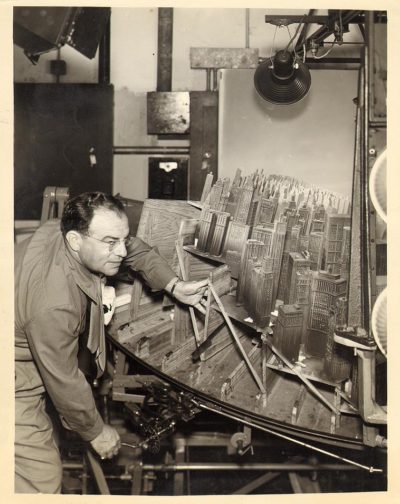Dave Fleischer (Dave Fleischer)

Dave Fleischer was the youngest of five brothers and grew up in Brownsville, Brooklyn, a poor Jewish ghetto. By the time Dave was born, his father has lost his means of livelihood due to The Industrial Revolution and the mass production of garments. Dave worked as an Usher at the famous Palace Theater on Broadway, where he was exposed to vaudeville, which contributed to the development of his sense for gags and comic timing, which came into play when he joined forces with his older brother, Max in the production of animated cartoons. At one point, the family lived in Coney Island, and Dave became interested in being a clown for one of the sideshow amusements. This clown character would be recalled a few years later in connection with Max’s early experiments with his first major invention, “The Rotoscope” and was the source of their first character who evolved into “Koko the Clown” in the pioneering series, Out of the Inkwell (1919-27). Around 1913–14, he began working as a film cutter for the American branch of Pathé, the French company that was the world’s largest film production and distribution company, and the largest manufacturer of film equipment in the first decades of the 20th Century.
In 1921, Dave Fleischer joined forces with Max in starting their first studio, Out of the Inkwell Films, Inc. in a dingy basement apartment in midtown Manhattan. He went on to become director and later supervising producer of the studio’s output. Among the cartoon series Fleischer supervised were Out of the Inkwell (1919-27), Inklings (1925-26), The Inkwell Imps (1927-29), Talkartoons (1929-32), Betty Boop (1932-39), Popeye the Sailor (1933-42), Color Classics(1934-41). He also supervised two animated features Gulliver’s Travels (1939) and Mr. Bug Goes to Town (1941). Following a relocation to Miami, Florida, and the production of their first feature, “Gulliver’s Travels,” Fleischer Studios became indebted to Paramount due to the cost overruns on “Gulliver” and losses in rentals on the new 1940s cartoon series produced under Dave’s control. The new series, including Stone Age, Gabby, and Animated Antics, were poorly received with theaters only valuing the Popeye cartoons. This forced the temporary surrender of Fleischer Studios to Paramount on May 24, 1941 while their final feature was contracted for completion.
Max Fleischer secured the license for “Superman” after Republic allegedly passed on the property as a potential serial. Budgeted at twice the cost of a Popeye cartoon, Superman, became the most successful cartoon of the late Fleischer Studio period, representing its maturing into the 1940s. Relations between the brothers deteriorated around 1938, which was aggravated further by Dave’s taking control of production starting in 1940, which resulted in the poorer cartoons produced under his control compounded by his continued rejection of Max’s input and late completion of films. Dave Fleischer resigned from Fleischer Studios in late November, 1941 following the recording of the score for Mr. Bug Goes to Town His official resignation was announced on December 31, 1941. He became Producer for Screen Gems at Columbia Pictures in April 1942, where he produced Song of Victory and Imagination, which were both nominated for Academy Awards. He also produced The Fox and Crow and Li’l Abner series, as well as the omnibus “Phantasies” series. In spite of the Oscar nominations, Harry Cohn fired Dave in 1944, replacing him with Harry Binder. Dave Fleischer approached Republic Pictures with an elf-like version of Koko the Clown, a character named “Snippy”, who was tried out as a live action/animation combo novelty at the end of the low-budget nightclub musical, Trocadero. A “Snippy” cartoon series never materialized, however. Fleischer continued a Republic as Associate Producer of the minute-long animation sequence for another “B” movie, That’s My Baby.
For a short period, Dave Fleischer had a comic strip for The Hollywood Citizen News. In the early 1950s, Dave animated a series of Technicolor theatrical “snipes” for the Filmac Trailer Company of Chicago. One of the most recognized in recent years, Let’s All Go to the Lobby, which is now among the collection in The National Film Registry as representative of American Culture along with his Betty Boop version of Snow White. Following a series of oddball assignments, Dave landed a permanent position as a “Technical Specialist” at Universal through animation veteran, Walter Lantz. At Universal, Dave was a Special Effects Technical and general problem-solver, working on films such as Francis (1950), The Birds (1963), and Thoroughly Modern Millie (1967). He was credited as “Technical Advisor” on Universal’s American release of the Russian animated feature, The Snow Queen (1959),supervising the English Language dubbing. He also supervised the animated title sequence for Abbott and Costello Meet Frankenstein. which has been assumed done by the Walter Lantz Studio. But Lantz had affiliated with United Artists at this time. Following his assignment on Thoroughly Modern Millie, Fleischer retired, and continued to live at the Peyton Hall apartment complex on Hollywood Boulevard until his death. Fleischer died of a stroke on June 25, 1979.
Born
- July, 14, 1894
- USA
- New York, New York
Died
- June, 25, 1979
- USA
- Hollywood, California
Cause of Death
- stroke
Cemetery
- Mount Sinai Memorial Park
- Los Angeles, California
- USA



